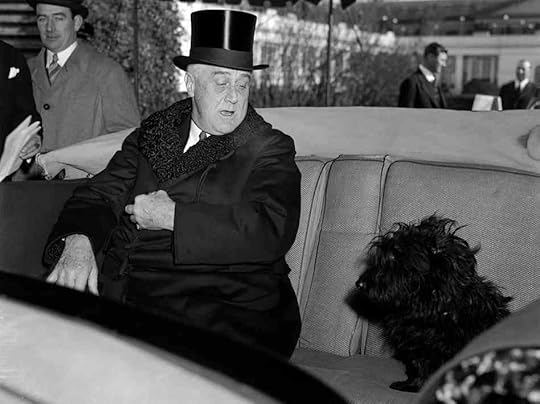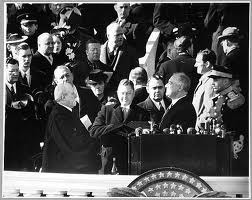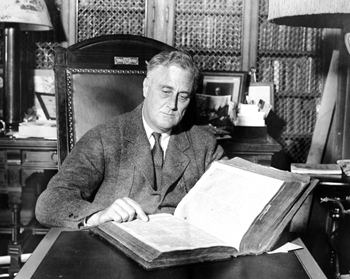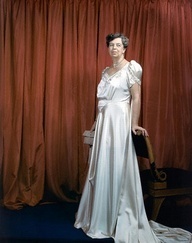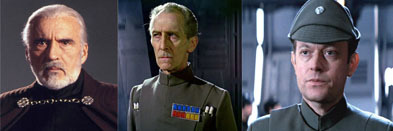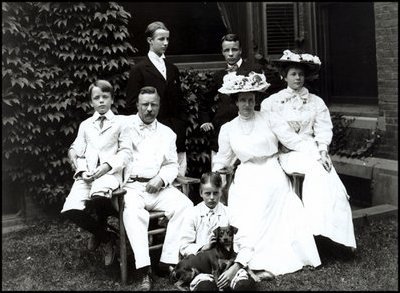Dee Garretson's Blog, page 8
January 21, 2013
Inauguration Follies and Foibles – The Roosevelt Years
Even important well-planned events can go awry, whether through forces of nature or human nature, and inaugurations are no exception. Those who remember President Obama first inauguration, may remember how Supreme Court Chief Justice John Roberts stumbled over the Oath of Office, but there has been a long history of minor gaffes and uncomfortable moments.
Franklin Roosevelt went through four inaugurations, and with that many, it’s not surprising there were some memorable moments. At the 1941 inauguration, Roosevelt used his own two hundred- year-old family bible for the swearing in. The bible was enormous, and a Supreme Court clerk, Charles Elmore Cropley, had been given the task of holding it before and after. The poor man dropped the bible not once but twice, in full view of the crowd. For the remainder of the ceremony clutched it to his chest so it wouldn’t get away again. Mr. Cropley is the man seen facing the camera between the President and the Chief Justice.
Given the size of this bible, Mr. Cropley can be forgiven for loosing his grip on it.
Shown in the picture at the top of the post, Roosevelt’s beloved terrier, Fala, tried to join his master on the way to the Inauguration in ‘41, jumping in the car and taking up his usual spot. Much to the dog’s dismay, he was removed by a security person to make room for the Speaker of the House and a senate leader.
It was Eleanor Roosevelt who found some inaugural details very trying. Never much interested in clothes, she agreed to be photographed for LIFE magazine posing in her various outfits for the inaugural events. You can tell from her expression she in not in her comfort zone. For the inauguration in 1945, Mrs. Roosevelt was not photographed in advance. Instead, LIFE ran a photo of the dressmaker who had made the dresses for all four inaugurations. Mrs. Roosevelt still managed to be subject to indignity because the dressmaker gave LIFE all the details of the first lady’s measurements and how they had changed over the years. No one would want the details of their hip measurements in a national magazine!
And because the 1945 inauguration was during World War II, the traditional post-inaugural luncheon reflected wartime shortages. Guests were served chicken salad, unbuttered rolls and frosting-free cake. Comedian George Jessel, the luncheon’s toastmaster, asked the crowd, “How is it humanly possible to make chicken salad with so much celery and so little chicken?”
Luckily, President Obama and his guests will dine today on a much more expanded menu:
First course:
• Steamed Lobster with New England Clam Chowder Sauce
• Sautéed Spinach
• Sweet Potato Hay
Second course:
• Hickory-Grilled Bison with Red Potato Horseradish Cake and Wild Huckleberry Reduction
• Butternut Squash Purée
• Baby Golden Beets and Green Beans
• Strawberry Preserve and Red Cabbage
Third course:
• Hudson Valley Apple Pie with Sour Cream Ice Cream, Aged Cheese and Honey Maple Caramel Sauce
• Artisan Cheeses
Wine:
• Tierce Finger Lakes Dry Riesling (2010)
• Korbel Natural, Special Inaugural Cuvée California Champagne
• Bedell Cellars Merlot (2009)
I’m not sure about the bison, but the rest sounds delicious.


December 13, 2012
Choosing Names from The Hobbit and Lord of the Rings for Your Cat or Dog
Thoren Oakenshield and an Australian Shepherd
As major Lord of the Rings Fans, our whole family is very excited about The Hobbit. When we recently brought a new cat into our family, we decided she needed a name from LOTR or The Hobbit. Since she is round and small with short legs, naming her after a hobbit seemed far more appropriate than choosing an elf name like Galadriel or a human name like Eowyn. But before we decided on her name (Poppy) we looked at many, many choices. Some would only work for the most elegant of cats or the most kingly of dogs, but there is a wide variety. I’m very tempted to get an Australian Shepherd just so I can name him Thoren Oakenshield. Here’s a list of names for anyone else trying to choose:
Female Hobbits
Angelica (Baggins)
Amaranth (Brandybuck)
Elanor (Gamgee)
Estella (Brandybuck)
Esmerelda (Took Brandybuck)
Gilly (Baggins)
Pansy (Baggins)
Poppy (Baggins)
Rosie (Cotton)
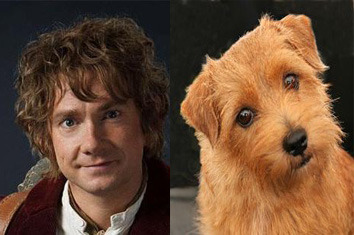
Bilbo Baggins and a Norfolk Terrier
Male Hobbits
Bilbo (Baggins)
Filibert (Bolgar)
Folco (Boffin)
Fosco (Baggins)
Frodo (Baggins)
Mungo (Baggins)
Madoc (Brandybuck)
Meriadoc (Brandybuck)
Peregrin (Took)
Pippin (Took-nickname of Peregrin)
Samwise (Gamgee)
Female Elves
Amarie
Anarie
Celebrian
Elenwe
Findis
Galadriel
Idril
Irime
Luthien
Miriel
Nellas
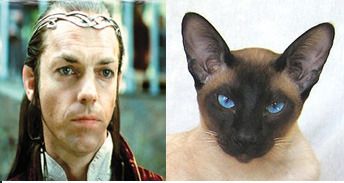
Elrond and a Siamese
Male Elves or Half Elves
Celeborn
Cirdan
Elrond
Elenwe
Figwit (fan-created name for elf in the movies)
Fingon
Finwe
Galdor
Gwindor
Haldir
Legolas
Lindir
Bombur and big orange cat
Male Dwarves
Balin
Bifur
Bofur
Bombur
Dain
Dori
Durin
Dwalin
Nain
Nori
Ori
(I haven’t found any choices for female dwarves.)
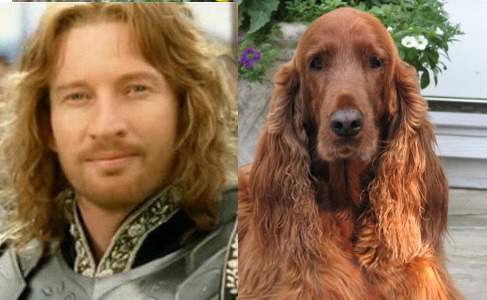
Faramir and an Irish Setter
Human Men
Aldor (Rohirrim)
Arador (Dunedain)
Aragorn (Dunedain)
Bard (of Dale)
Boromir (Gondor)
Faramir (Gondor)
Brego (Rohirrim)
Elendil (Second Age)
Eomer (Rohirrim)
Eradan (Dunedain)
Fengel (Rohirrim)
Gamling (Rohirrim)
Grima (Rohirrim)
Hama (Rohirrim)
Madril (only in LOTR movies)
Theoden (Rohirrim)
Thengel (Rohirrim)
Turin (First Age)
Human Women
Eowyn (Rohirrim)
Frea (Rohirrim)
Gilraen (Aragorn’s mother)
Other
Arda (Earth in LOTR)
Elanor (small star-shaped yellow flower)
Goldberry (female river spirit)
Lissuin (fragrant flower)
Nenya (Elf ring)
Tom Bombadil (Tolkien referred to him as a nature spirit)
And here’s the kitten who started this all:
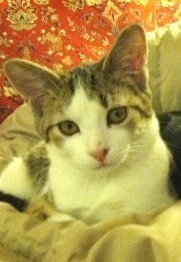
Poppy
More Hobbitness: How to Make a Bilbo’s Bag End Cake: http://deegarretson.wordpress.com/2011/09/25/lord-of-the-rings-hobbit-cake-bilbos-bag-end/


September 23, 2012
Author Skype Visits for Scholastic Book Fairs
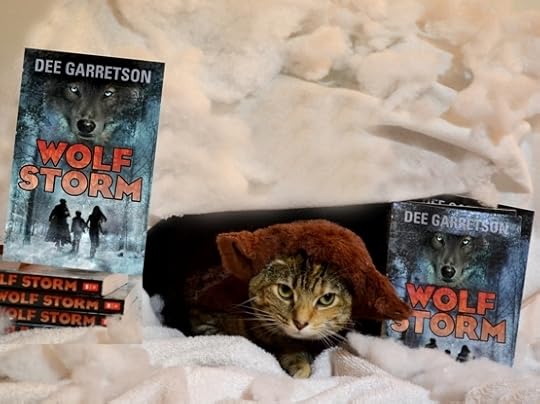 I know my cat doesn’t look happy to be dressed up as a wolf in this photo, but I am very happy WOLF STORM is a Scholastic Book Club choice this fall. To celebrate, I’m offering free author Skype visits of 20 to 30 minutes to any school having a book fair. I tailor my Skype visits to a school’s or teacher’s particular interest. I can talk about the writing process, writing adventure books in particular, or do an introduction to the books and spend much of the time answering students’ question on whatever topics they choose. More information about WOLF STORM and my other middle grade book, WILDFIRE RUN, can be found by going to my website at http://deegarretson.com/ You can view the book trailers and read the first chapters. Feel free to contact me at deegarretson at gmail.com
I know my cat doesn’t look happy to be dressed up as a wolf in this photo, but I am very happy WOLF STORM is a Scholastic Book Club choice this fall. To celebrate, I’m offering free author Skype visits of 20 to 30 minutes to any school having a book fair. I tailor my Skype visits to a school’s or teacher’s particular interest. I can talk about the writing process, writing adventure books in particular, or do an introduction to the books and spend much of the time answering students’ question on whatever topics they choose. More information about WOLF STORM and my other middle grade book, WILDFIRE RUN, can be found by going to my website at http://deegarretson.com/ You can view the book trailers and read the first chapters. Feel free to contact me at deegarretson at gmail.com


May 16, 2012
Ten Things You Might Not Know about Camp David
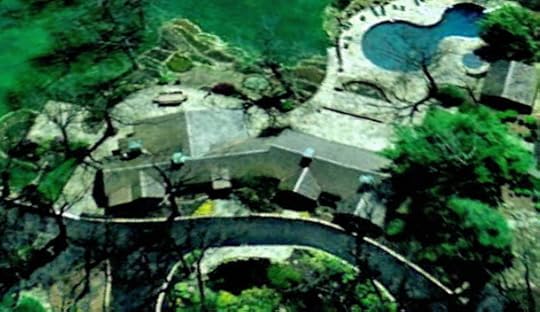 When I decided to write WILDFIRE RUN, originally titled ESCAPE FROM CAMP DAVID, I didn’t realize quite how difficult it would be to find information about presidential retreat. While my book is fiction, I wanted enough accurate details to give readers a believable idea of the setting.
When I decided to write WILDFIRE RUN, originally titled ESCAPE FROM CAMP DAVID, I didn’t realize quite how difficult it would be to find information about presidential retreat. While my book is fiction, I wanted enough accurate details to give readers a believable idea of the setting.
The basics about Camp David can be found in numerous sources. The Presidential retreat was first used by Franklin Delano Roosevelt during World War II when it was deemed too dangerous to allow him to pursue one of his favorite pastimes, yachting. Several sites were considered, and a former summer camp in the Catoctin Mountains was chosen. It was designated as a Navy base, guarded by Marines. FDR named the place Shangri-La, but Dwight Eisenhower later changed the name to Camp David, after his grandson, David.
One of the best sources on the retreat is the book THE PRESIDENT IS AT CAMP DAVID by W. Dale Nelson, a reporter for the Associated Press. Other ways to find out little details of history outside the headlines comes from the memoirs and biographies of people who have been there.
1. Most details show the more human side of the Presidents and First Ladies, but one incident in particular could have been part of a plot of a thriller novel. President Jimmy Carter arranged for a summit meeting to be held at Camp David to work on some solution to the conflicts in the Middle East. Tensions ran very high between the Arab and Israeli attendees. After several days of intense negotiations which seemed to be leading nowhere, President Carter supposedly called his national security advisor, Zbigniew Brzezinski at 4:15 in the morning because he was worried the Egyptian leader, Anwar Sadat, might have been assassinated by some of the group accompanying him. Carter had gone to visit Sadat as his cabin at ten o’clock, only to be told Sadat was asleep, even though all the lights were on. Sadat was fine and the resulting agreement made Camp David known around the world. (Nelson)
Anwar Sadat was assassinated in Egypt three years later by some of the Egyptian military who were opposed to peace with Israel.
2. Franklin Delano Roosevelt enjoyed Camp David (named Camp Shangri-La then) a great deal, even though at that time, living conditions were still somewhat primitive. Many of the cabins were unheated and without running water. Because FDR was confined to a wheelchair much of the time, he had a great fear of being trapped in a fire. A section of the wall of the bedroom he slept in was adapted so that it could be opened and turned into a ramp from the bedroom to the outside. (Nelson)
3. Many world leaders have visited Camp David, some enjoying it more than others. Soviet leader Leonid Brezhnev came to Camp David to meet with President Richard Nixon. Brezhnev collected luxury cars, and an American firm decided to give him a Lincoln Continental. Nixon presented it to him at Camp David. According to Nixon, Brezhnev got in the car and motioned Nixon in the passenger seat. Nixon complied, much to the distress of the Secret Service, and Brezhnev sped off around the narrow winding roads at Camp David, Nixon pleading for him to slow down on some of the more treacherous ones. Brezhnev didn’t listen, afterwards praising the car for its ability to hold the road. (Whitcomb)
4. Since Presidents don’t normally drive themselves while in office, some have taken advantage of the ability to get behind the wheel at Camp David, narrow roads and all. In Hillary Clinton’s memoirs, she talks about President Clinton deciding Camp David would be the perfect spot to teach daughter Chelsea to drive. He borrowed one of the cars in the Secret Service fleet and Mrs. Clinton writes, “Outside of golf carts, the Secret Service never let Bill drive himself around, which was a good thing. It’s not hat my husband isn’t mechanically inclined, it’s just that he has so much information running round his head at any given moment that he doesn’t always notice where he was going.” Chelsea and President Clinton survived the experience, but Mrs. Clinton doesn’t refer to any more driving lessons. (Clinton)
Barark Obama reports that he does drive a golf cart around Camp David, and it’s called Golf Cart One.
5. Not even golf carts are completely safe. Israeli leader Menachem Begin got bumped by one driven by eleven-year-old Mika Brzezinski, the daughter of President Carter’s National Security advisor, Zbigniew Brzezinski. In her memoirs, Mika writes that she asked Amy Carter if she could drive a golf cart, even though she didn’t know how. Amy turned over the wheel and Mika managed to bump into Begin’s shins as he was standing next to Anwar Sadat. (Brzezinski)
6. While no reports of Presidents being in car accidents at Camp David have been reported, Presidents have injured themselves there. Jimmy Carter suffered three separate injuries requiring the attention of the White House doctor. Once from falling off a bicycle, and twice from cross country skiing, breaking his collar bone in one particularly bad fall. (Carter)
7. Even one First Lady suffered an injury there, from sledding of all things. Barbara Bush writes in her memoir that one particularly snowy weekend, most people there greatly enjoyed the sledding one day, and the next day, she hurried out to be one of the first down, taking off on a saucer sled. She didn’t realize that because there had been a thaw and a refreeze during the night, the slope was much icier than it had been the day before. The saucer began spinning around and around, picking up speed and she writes that President Bush was yelling “Bail out! Bail out!” but she didn’t. She hit a tree, fracturing her fibula. (Bush)
8. Over the years there have been many outdoor activities available at Camp David, including archery, horseback riding, hiking, skeet shooting and horseshoes. A new swimming pool was built during the administration of Richard Nixon. Nixon wanted the new pool close to the Presidential lodge. No one told him that the cost would be very high to place a pool at that site, because it was directly over the bomb shelter, whose ceiling had to be reinforced to support the weight of the water. (Nelson)
9. Presidents and their families have treasured the informality of the place and they usually dress much more informally at Camp David, sometimes perhaps a bit too informally. President George H.W. Bush’s daughter Dorothy held her wedding there, so she could have a quiet wedding without any media attention. According to Barbara Bush in her memoirs, President Bush waited until the morning of the ceremony to ask what he should wear. When told he should wear a blue suit, he confessed he didn’t bring one, assuming the wedding would be casual. Mrs. Bush writes, “He did come up with a blue blazer, a white shirt, and some 20-year-old white summer pants with a thin blue stripe which the boys call his ‘New York Yankee” pants.” (Bush)
10. White House dogs have generally also loved the freedom of Camp David. Most reportedly learn to love the helicopter ride there, and once they arrive, spend their time chasing squirrels. The President’s dog, no matter how small, always gets the top dog billing and privileges. Vice President Dick Cheney writes of how his own dog, Dave, a yellow Labrador, discovered his secondary status. One day, Cheney took Dave to Laurel, the main building at Camp David. Once inside, Dave spotted Barney, President Bush’s Scottie. According to Cheney, “Barney was only slightly larger than the squirrels Dave so much loved chasing.” Dave chased Barney around the building until Cheney managed to distract him with a breakfast pastry. After that, the Camp Commander informed the Vice President that Dave was banned from Laurel. (Cheney)
Sources:
THE PRESIDENT IS AT CAMP DAVID by W. Dale Nelson
REAL LIFE AT THE WHITE HOUSE by John Whitcomb and Claire Whitcomb
LIVING HISTORY by Hillary Rodham Clinton
ALL THINGS AT ONCE by Mika Brzezinski
WHITE HOUSE DIARY by Jimmy Carter
BARBARA BUSH A MEMOIR by Barbara Bush
IN MY TIME: A Personal and Political Memoir by Dick Cheney and Liz Cheney








May 5, 2012
Sherlock Holmes Actors and the Star Wars & Star Trek Connections
It was recently announced that Benedict Cumberbatch, of the new Sherlock Holmes series on BBC, will have a role in the next Star Trek movie, possibly as archenemy Khan. He won’t be the first Sherlock to have a connection with popular science fiction films. Star Wars has had three prominent actors who also played Sherlock Holmes at various times in their careers.
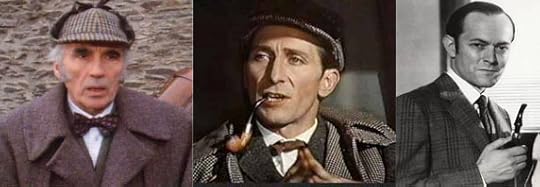
Christopher Lee, Peter Cushing, Michael Pennington
Christopher Lee was Count Dooku in Attack of the Clones and Revenge of the Sith. He played Holmes in Sherlock Holmes and the Deadly Necklace, 1962. Later in his career, he played Holmes two more times in Sherlock Holmes and the Leading Lady, a television movie from 1990, and Incident at Victoria Falls, another television movie in 1991.
Peter Cushing was Grand Moff Tarkin, commander of the first Death Star in A New Hope. He played Sherlock Holmes a number of times, over a span of twenty-five years in: The Hound of the Baskervilles (1959), the first Holmes film made in colour, Sir Arthur Conan Doyle’s Sherlock Holmes (1968), sixteen episodes of a BBC series of which only six episodes remain and in The Masks of Death (1984) a made-for-television movie
Michael Pennington who was Moff Tiaan Jerjerrod, commanding officer of the second Death Star in Return of the Jedi played Holmes in The Return of Sherlock Holmes, a television movie from 1987.
There are a couple of other Star Trek connections as well. Christopher Plummer, best known for his role in The Sound of Music, played Sherlock in Murder by Decree, 1979. He was also General Chang in Star Trek VI: The Undiscovered Country.
Mr. Spock has to be the twentieth century character most resembling Sherlock Holmes. Leonard Nimoy, who played Spock in the original Star Trek series and the later movies, actually played Sherlock Holmes on stage in a Royal Shakespeare production in 1976.
In Star Trek VI: The Undiscovered Country, Spock gives us a clue to his background, when he says, “An ancestor of mine maintained that if you eliminate the impossible, whatever remains – however improbable – must be the truth.”
Perhaps Zachery Quinto, who plays Spock in the new Star Trek movies, will take his turn as Sherlock.
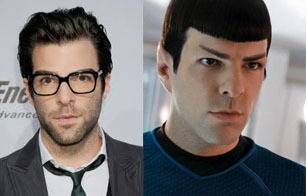
For more Sherlock, Sherlock Holmes Actors - The Best and the Worst (on my other blog)








March 4, 2012
To Do and To Don’t List for Middle Grade Debut Authors
 There is no instruction manual for debut authors, and middle grade authors face some extra challenges. Our readers, 9 to 12-year-olds, are not getting their information about new books from authors themselves or from the internet, for the most part. They find out about books from teachers, librarians, parents, grandparents and friends who have heard about books from these same sources.
There is no instruction manual for debut authors, and middle grade authors face some extra challenges. Our readers, 9 to 12-year-olds, are not getting their information about new books from authors themselves or from the internet, for the most part. They find out about books from teachers, librarians, parents, grandparents and friends who have heard about books from these same sources.
As a middle grade author, it’s easy to spend far too much time worrying about the wrong things. For example, many debut authors obsess over a release party, which while it may be fun, is not actually very important in the long run toward getting your book known. Nor is it all that useful to spend large amounts of time trying to set up book signings. For an unknown author, your target audience is usually not in a bookstore, nor will they even hear about the signing. Even if they did, it would have to be at a time that didn’t conflict with homework, sports, recitals or the myriad of other activities a child does, and it would have to be at a time a parent would make the effort to get them to a bookstore.
I’ve made a list of some of the potentially useful things you can do as you prepare for your debut. Most of these I learned from trial and error, actually mostly error, and I wanted to share them so future debut authors may not flounder quite as much as I did. You won’t be able to do all of them, nor should you, because your most important job is writing the next book after the debut, even if you don’t have a contract or a publisher for it yet. Protect your writing time above all. You don’t have to do any of these.
These are in no particular order of importance or timing:
1. When you have a release date, find bloggers who are doing debut challenges for your release year. A debut challenge is where pick a certain number of books by debut authors they plan to read. This is one of the reasons bloggers are so valuable and should be appreciated for all the time they give just out of love of books. You want to get the name of your book out there, so people can start to become aware of its existence. Just google “debut challenge middle grade” or debut challenge mg.” When you find bloggers who are doing challenges, send them an email to let them know your book qualifies.
2. Search out the internet groups of YA and MG debut authors who have banded together to help each other. Because there are fewer MG debuts, they usually join forces with YA authors. The membership for these groups often closes in the fall of the year before the debut, so don’t put this off if you want to join. They are great support for authors, and you’ll gain from the individual experiences that people will share. Once in a group, participate regularly and try to help others get the word out about their own books. To find these, google “debut authors ”
3. Get a website. If you don’t want to pay for one and/or feel uncomfortable adding content to one, you can use one of the free blogging sites instead. You won’t be able to make it look exactly like a traditional website (as far as I can tell), but it’s far better than not having one at all. Mine is very simple, but works for me. If you want some ideas, here’s the link to it: http://deegarretson.com . The goal of your website is to be able to add content that readers, teachers and librarians will find useful.
4. Get a Twitter account and figure out how to use it. The purpose of Twitter is not to continually talk about your book; it’s to connect with other people out there who are readers and avid supporters of kidlit. In fact, if you just talk about your book, you will annoy people and they won’t keep following you. Start following other writers, teachers and librarians. Participate in tweetchats such as #kidlitchat and #mglitchat.
5. Read and comment on other middle grade books you enjoy. Sometimes it seems as if certain writers never read anything besides their own book, and if you want to be part of the kidlit community, you have to participate in it. Twitter is a good place to pass on recommendations of other books.
6. Join Goodreads, Librarything or Shelfari. This is not for the purpose of reading the reviews that will eventually be posted there. In fact, you may drive yourself crazy reading reviews, so it’s perfectly okay not to read them. You want an account on these sites to be able to offer giveaways of your books and to let other people know a bit more about you and what you’re reading.
7. As soon as you get advance copies, offer a giveaway on one of the sites above. You’ll want to offer giveaways periodically, not just with your advance copies, to keep reminding people of your title and cover.
8. Decide if you are going to have a blog and/or if you are going to participate in a group blog. Blogging is time-consuming, but it allows you a way to connect with potential readers. The most effective blogging entries won’t just be about your book. If you can add content that is either somehow related to something in your book, or if you can post entertaining entries about your life and interests, people will find you. The entries on my blog that get the most hits are posts about U.S. Presidents. I’m hoping someone interested in history may also be interested enough to find out more about my book featuring a (fictional) Presidential kid.
9. Follow and comment on existing middle grade group blogs, and blogs by kidlit authors who blog regularly. You’ll learn quite a bit about the community of kidlit enthusiasts. I’m much more likely to move a debut book to the top of my TBR pile if I remember seeing the author’s name somewhere or have had some interaction with them (positive interaction-if a person is too snarky or self-centered, then I’m not inspired to read their book.)
Here’s just a few:
Project Mayhem (this is the one I joined) http://project-middle-grade-mayhem.blogspot.com/
From the Mixed Up Files of Middle Grade Authors: http://www.fromthemixedupfiles.com/
Operation Awesome: http://operationawesome6.blogspot.com/
10. Contact book bloggers and ask for reviews. Not everyone will agree, because bloggers get inundated with requests, so don’t get discouraged if someone says no.
11. Decide if you are going to make a book trailer. Every person seems to have a different opinion on the value of these. I like them because I use them as a way to easily introduce my book to bloggers, librarians and teachers. There is an expense involved and it may not be worth it to you, so it’s certainly not going to cause your book to fail if you don’t have one. You can see my two on the first page of my website: http://deegarretson . I’ve also got a blog post that details how much it cost me to make the WOLF STORM trailer: http://bit.ly/pqoJS0
12. Decide if you are going to do a blog tour. It took me a long time to figure out exactly what they are. Here’s a good explanation of blog tours from the Book Publicity Blog: http://yodiwan.com/2009/06/11/whats-a-book-blog-tour/ If you are going to do this, give yourself plenty of time to set up a good one, and give the bloggers plenty of time to read your book.
13. Order bookmarks. You’ll want to pass these out whenever you get an opportunity. I find them more useful than business cards. Have your email address on them as well as your website and blog addresses. You can spend quite a bit more on other giveaways if you really want to indulge in what’s called “swag,” but I’m not sure the cost is worth it for middle grade. I spent $250 dollars on some really amazing combination flashlight/compass/carabiners to give out for special events with the words “Danger’s Edge” printed on them. Unfortunately, “Danger’s Edge” got taken off the book cover, so I have a box full still sitting in my basement.
14. Figure out how to use Skype. Offering free twenty minute Skype sessions to classes or book clubs is a good way to connect with potential readers.
15. Write a book club discussion guide and/or a teacher’s guide for your book. These are to post on your website or blog so that people can download them. If you want ideas on how to do them, you can see mine here. For teacher’s guides: http://deegarretson.com/teachersguide.html For book club discussion guides: http://deegarretson.wordpress.com/book-club-discussion-questions/
16. Decide if you are going to do school visits, and if you are, prepare some talks. The best talks are not just about you and your book. Try to find some extra content on writing or books that will appear to teachers. As a debut author in an economy where school budgets are extremely limited, you’ll have to decide if you are going to charge or not. Some authors do not if the school will send home order forms for the books. Often, schools have arrangements already in place with local bookstores. If they don’t, a bookstore should be willing to set this up.
17. Look into local book fairs. You usually have to apply to attend these several months in advance, but they are a good way to let people in your area know about your books. Teachers and librarians often attend. If you do go, have bookmarks to hand out, information about your willingness to Skype and any guides you’ve made.
18. Get a Facebook author page. This will have limited use for a middle grade author, partly because children under thirteen aren’t supposed to be on Facebook, and the ones that are mostly spend their time interacting with their own friends rather than seeking out authors. However, you may have some readers seeking you out.
Now that you may be exhausted from reading this all, I’ll just reiterate, you get to choose how much or how little you do. Above all, keep writing!








To Do and To Don't List for Middle Grade Debut Authors
 There is no instruction manual for debut authors, and middle grade authors face some extra challenges. Our readers, 9 to 12-year-olds, are not getting their information about new books from authors themselves or from the internet, for the most part. They find out about books from teachers, librarians, parents, grandparents and friends who have heard about books from these same sources.
There is no instruction manual for debut authors, and middle grade authors face some extra challenges. Our readers, 9 to 12-year-olds, are not getting their information about new books from authors themselves or from the internet, for the most part. They find out about books from teachers, librarians, parents, grandparents and friends who have heard about books from these same sources.
As a middle grade author, it's easy to spend far too much time worrying about the wrong things. For example, many debut authors obsess over a release party, which while it may be fun, is not actually very important in the long run toward getting your book known. Nor is it all that useful to spend large amounts of time trying to set up book signings. For an unknown author, your target audience is usually not in a bookstore, nor will they even hear about the signing. Even if they did, it would have to be at a time that didn't conflict with homework, sports, recitals or the myriad of other activities a child does, and it would have to be at a time a parent would make the effort to get them to a bookstore.
I've made a list of some of the potentially useful things you can do as you prepare for your debut. Most of these I learned from trial and error, actually mostly error, and I wanted to share them so future debut authors may not flounder quite as much as I did. You won't be able to do all of them, nor should you, because your most important job is writing the next book after the debut, even if you don't have a contract or a publisher for it yet. Protect your writing time above all. You don't have to do any of these.
These are in no particular order of importance or timing:
1. When you have a release date, find bloggers who are doing debut challenges for your release year. A debut challenge is where pick a certain number of books by debut authors they plan to read. This is one of the reasons bloggers are so valuable and should be appreciated for all the time they give just out of love of books. You want to get the name of your book out there, so people can start to become aware of its existence. Just google "debut challenge middle grade" or debut challenge mg." When you find bloggers who are doing challenges, send them an email to let them know your book qualifies.
2. Search out the internet groups of YA and MG debut authors who have banded together to help each other. Because there are fewer MG debuts, they usually join forces with YA authors. The membership for these groups often closes in the fall of the year before the debut, so don't put this off if you want to join. They are great support for authors, and you'll gain from the individual experiences that people will share. Once in a group, participate regularly and try to help others get the word out about their own books. To find these, google "debut authors "
3. Get a website. If you don't want to pay for one and/or feel uncomfortable adding content to one, you can use one of the free blogging sites instead. You won't be able to make it look exactly like a traditional website (as far as I can tell), but it's far better than not having one at all. Mine is very simple, but works for me. If you want some ideas, here's the link to it: http://deegarretson.com . The goal of your website is to be able to add content that readers, teachers and librarians will find useful.
4. Get a Twitter account and figure out how to use it. The purpose of Twitter is not to continually talk about your book; it's to connect with other people out there who are readers and avid supporters of kidlit. In fact, if you just talk about your book, you will annoy people and they won't keep following you. Start following other writers, teachers and librarians. Participate in tweetchats such as #kidlitchat and #mglitchat.
5. Read and comment on other middle grade books you enjoy. Sometimes it seems as if certain writers never read anything besides their own book, and if you want to be part of the kidlit community, you have to participate in it. Twitter is a good place to pass on recommendations of other books.
6. Join Goodreads, Librarything or Shelfari. This is not for the purpose of reading the reviews that will eventually be posted there. In fact, you may drive yourself crazy reading reviews, so it's perfectly okay not to read them. You want an account on these sites to be able to offer giveaways of your books and to let other people know a bit more about you and what you're reading.
7. As soon as you get advance copies, offer a giveaway on one of the sites above. You'll want to offer giveaways periodically, not just with your advance copies, to keep reminding people of your title and cover.
8. Decide if you are going to have a blog and/or if you are going to participate in a group blog. Blogging is time-consuming, but it allows you a way to connect with potential readers. The most effective blogging entries won't just be about your book. If you can add content that is either somehow related to something in your book, or if you can post entertaining entries about your life and interests, people will find you. The entries on my blog that get the most hits are posts about U.S. Presidents. I'm hoping someone interested in history may also be interested enough to find out more about my book featuring a (fictional) Presidential kid.
9. Follow and comment on existing middle grade group blogs, and blogs by kidlit authors who blog regularly. You'll learn quite a bit about the community of kidlit enthusiasts. I'm much more likely to move a debut book to the top of my TBR pile if I remember seeing the author's name somewhere or have had some interaction with them (positive interaction-if a person is too snarky or self-centered, then I'm not inspired to read their book.)
Here's just a few:
Project Mayhem (this is the one I joined) http://project-middle-grade-mayhem.blogspot.com/
From the Mixed Up Files of Middle Grade Authors: http://www.fromthemixedupfiles.com/
Operation Awesome: http://operationawesome6.blogspot.com/
10. Contact book bloggers and ask for reviews. Not everyone will agree, because bloggers get inundated with requests, so don't get discouraged if someone says no.
11. Decide if you are going to make a book trailer. Every person seems to have a different opinion on the value of these. I like them because I use them as a way to easily introduce my book to bloggers, librarians and teachers. There is an expense involved and it may not be worth it to you, so it's certainly not going to cause your book to fail if you don't have one. You can see my two on the first page of my website: http://deegarretson . I've also got a blog post that details how much it cost me to make the WOLF STORM trailer: http://bit.ly/pqoJS0
12. Decide if you are going to do a blog tour. It took me a long time to figure out exactly what they are. Here's a good explanation of blog tours from the Book Publicity Blog: http://yodiwan.com/2009/06/11/whats-a-book-blog-tour/ If you are going to do this, give yourself plenty of time to set up a good one, and give the bloggers plenty of time to read your book.
13. Order bookmarks. You'll want to pass these out whenever you get an opportunity. I find them more useful than business cards. Have your email address on them as well as your website and blog addresses. You can spend quite a bit more on other giveaways if you really want to indulge in what's called "swag," but I'm not sure the cost is worth it for middle grade. I spent $250 dollars on some really amazing combination flashlight/compass/carabiners to give out for special events with the words "Danger's Edge" printed on them. Unfortunately, "Danger's Edge" got taken off the book cover, so I have a box full still sitting in my basement.
14. Figure out how to use Skype. Offering free twenty minute Skype sessions to classes or book clubs is a good way to connect with potential readers.
15. Write a book club discussion guide and/or a teacher's guide for your book. These are to post on your website or blog so that people can download them. If you want ideas on how to do them, you can see mine here. For teacher's guides: http://deegarretson.com/teachersguide.html For book club discussion guides: http://deegarretson.wordpress.com/book-club-discussion-questions/
16. Decide if you are going to do school visits, and if you are, prepare some talks. The best talks are not just about you and your book. Try to find some extra content on writing or books that will appear to teachers. As a debut author in an economy where school budgets are extremely limited, you'll have to decide if you are going to charge or not. Some authors do not if the school will send home order forms for the books. Often, schools have arrangements already in place with local bookstores. If they don't, a bookstore should be willing to set this up.
16. Look into local book fairs. You usually have to apply to attend these several months in advance, but they are a good way to let people in your area know about your books. Teachers and librarians often attend. If you do go, have bookmarks to hand out, information about your willingness to Skype and any guides you've made.
17. Get a Facebook author page. This will have limited use for a middle grade author, partly because children under thirteen aren't supposed to be on Facebook, and the ones that are mostly spend their time interacting with their own friends rather than seeking out authors. However, you may have some readers seeking you out.
Now that you may be exhausted from reading this all, I'll just reiterate, you get to choose how much or how little you do. Above all, keep writing!








February 26, 2012
Kidlit Fiction about Child Movie Actors and Oscar Trivia – Nominated Kids

Tatum O'Neal
I did quite a bit of research on child actors to write WOLF STORM, and even though I never had a desire to act as a child (direct, yes!), it's fascinating to consider what they go through and how they live their lives. I've got a short book list at the end of the post about other fictional movie and tv actors, but first, because I'm thinking about the Oscars today, I went back and did some research on child nominees. No child or teen has ever won the Best Actor award, and only a few have been nominated.
Best Actor Nominee:
Jackie Cooper, 9 years old for Skippy released in 1930
Mickey Rooney, 19 years old for Babes in Arms, released in 1939
Best Actress Nominee:
Keisha Castle-Hughes, 13 years old for Whale Rider, 2003
There have been child and teen winners in the Best Supporting Actress Category:
Tatum O'Neal, 10 years old for Paper Moon released in1973
Anna Paquin, 11 years old for The Piano released in 1993
Patty Duke, 16, The Miracle Worker released in 1962
A 10-year-old actress named Mary Badham was nominated for one of my favorite movies, To Kill a Mockingbird. I thought her portrayal of Scout was just perfect.
Several other children and teens have been nominated for the best supporting actor and actress categories, and the record for the youngest is held by Justin Henry, who was eight when he was nominated for Kramer vs. Kramer, released in 1979
I've been trying to find some kidlit fiction with young movie and television actors as main characters, but so far the list is fairly small:
Chapter books:
ANNABELLE THE ACTRESS series by Ellen Conford-The series follows Annabelle's attempts to become an actress, so it isn't until the third book that she finds a way into a movie shoot.
Middle Grade
REBECCA AND THE MOVIES (American Girl) by Jacqueline Greene
MOVIE SHOES by Noel Steitfeild
MIRANDA AND THE MOVIES by Jane Kendall
WOLF STORM by Dee Garretson (that's me)
TYLER ON PRIME TIME by Steve Atinsky
Young Adult
SECRETS OF MY HOLLYWOOD LIFE series by Jen Calonita
If you know of more, please leave a comment and I'll add to the list.
One of the main resources I used for my research just to get a feel for how children live and work on a movie set location was watching the behind-the-scenes features on the extended edition of The Chronicles of Narnia; The Lion, The Witch and The Wardrobe. It was a terrific way what happens when children of different ages and different experiences are put together to act like a family.








February 20, 2012
Fun Facts about the Presidents #4 – Which President loved animals and let his children have a piebald rat named Jonathan live at the White House?
Theodore Roosevelt was very fond of pets and let his children keep a whole assortment of them at the White House, including the piebald rat named Jonathan. Unfortunately, there is no photograph of Jonathan, but there are some of the many Roosevelt dogs. Here's a picture of the family with Skip:
And here's a picture of Theodore with two of the other dogs:
In his many letters to friends and family he often talked about the animals:
"At this moment, my small daughter being out, I am acting as nurse to two wee guinea pigs, which she feels would not be safe save in the room with me." letter to a friend, October 20, 1902
And he wrote to his son Archie in 1908:
"Mother continues much attached to Scamp, who is certainly a cunning little dog. He is very affectionate, but so exceedingly busy when we are out on the grounds, that we only catch glimpses of him zigzagging at full speed from one end of the place to the other. The kitchen cat and he have strained relations but have not yet come to open hostility."
Here's just a partial list of some of their other pets:
Sailor Boy, a Chesapeake Bay retriever
Manchu, a Pekingese
Skip, a mutt
Jack and Pete and Scamp, assorted terriers
Tom Quartz and Slippers, cats
Josiah the badger
Algonquin the pony
Eli the macaw
Jonathan the piebald rat
Emily Spinach, a garter snake
Dewey Senior, Dewey Junior, Bob Evans, Bishop Doan, and Father O'Grady, all guinea pigs
 Teddy Roosevelt and family were fascinating. To learn more about them check out THEODORE ROOSEVELT FOR KIDS: HIS LIFE AND TIMES, 21 ACTIVITIES (FOR KIDS SERIES) by Kerrie Logan Hollihan.
Teddy Roosevelt and family were fascinating. To learn more about them check out THEODORE ROOSEVELT FOR KIDS: HIS LIFE AND TIMES, 21 ACTIVITIES (FOR KIDS SERIES) by Kerrie Logan Hollihan.
Here are a few other posts about the Presidents:
Which President was a good cook? (recipe included)
Which President noticed the White House was about to fall down?
Which President got married in the White House and who was the youngest First Lady?
How to memorize the Presidents in Order X-Men Style:
http://deegarretson.wordpress.com/2010/09/19/how-to-memorize-the-presidents-in-order-x-men-version/
Who were the smartest Presidents?
http://deegarretson.wordpress.com/2010/08/14/who-were-the-smartest-u-s-presidents/








Fun Facts about the Presidents #3 – Which President got married in the White House and who was the youngest First Lady? (It wasn’t Jackie Kennedy.)
In honor of President’s Day, and of all the Presidents who have served our country, I thought I’d do a series of blog posts with interesting information about individual Presidents. Here’s the latest:
 Frances Folsom Cleveland was only twenty-one when she married President Grover Cleveland. They had kept their courtship a secret because President Cleveland was worried that people would be upset about the age difference between the two. He was forty-nine at the time.
Frances Folsom Cleveland was only twenty-one when she married President Grover Cleveland. They had kept their courtship a secret because President Cleveland was worried that people would be upset about the age difference between the two. He was forty-nine at the time.
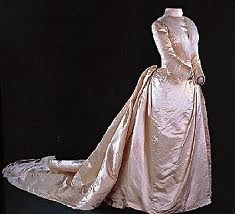
 The two announced their plans to marry only a few days before the wedding and the press went crazy trying to find out any detail about the wedding they could, down to pictures of the factory where the wedding cake boxes were being produced. These satin-covered boxes were trimmed with lace and given to the guests.
The two announced their plans to marry only a few days before the wedding and the press went crazy trying to find out any detail about the wedding they could, down to pictures of the factory where the wedding cake boxes were being produced. These satin-covered boxes were trimmed with lace and given to the guests.
Frances was a very popular First Lady and women copied her hairstyles and clothing. She was well-educated, having graduated from one of the first liberal arts colleges for women, Wells College. At college she studied botany, astronomy, logic, and religious studies, but her favorite courses were in political science. While in the White House, she became interested in the working conditions of women and supported organizations to help them.
The Clevelands had six children, and by all accounts, a very happy marriage.
Here are more posts about the Presidents:
Which President was a good cook? (recipe included)
Which President noticed the White House was about to fall down?
How to memorize the Presidents in Order X-Men Style:
http://deegarretson.wordpress.com/2010/09/19/how-to-memorize-the-presidents-in-order-x-men-version/
Who were the smartest Presidents?
http://deegarretson.wordpress.com/2010/08/14/who-were-the-smartest-u-s-presidents/









